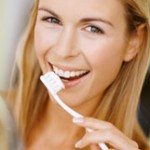Home Care
Prevention and early detection are important when it comes to taking care of your mouth and your teeth. Poor oral hygiene can lead to gingival inflammation, eventual bone loss, and possibly tooth loss if not treated in a timely manner. Likewise unchecked or untreated tooth decay can lead to tooth pain, loss of tooth structure, possible root canal, or even tooth loss. A thorough examination and regular checkups by your dentist are recommended twice a year.
The Brush To Use
Hard bristles were once recommended but now are thought to be too abrasive to the teeth and gums. It now is suggested that a soft, rounded-end nylon bristle brush be used . Be sure to discard brushes when the bristles are bent or frayed or every three to four months.
How To Brush
 Begin by placing the head of the brush beside your teeth, with the bristles angled against the gum line (where the teeth and gums meet ). Think of the brush as both a toothbrush and a gum brush. With the bristles contacting both tooth and gum, move the brush gently in an elliptical motion across each tooth individually. Use a short stroke and a gentle scrubbing motion, as if the goal were to massage the gum. Don’t try to force the bristles under the gum line; that will happen naturally, especially with a brush that has soft, flexible bristles.
Begin by placing the head of the brush beside your teeth, with the bristles angled against the gum line (where the teeth and gums meet ). Think of the brush as both a toothbrush and a gum brush. With the bristles contacting both tooth and gum, move the brush gently in an elliptical motion across each tooth individually. Use a short stroke and a gentle scrubbing motion, as if the goal were to massage the gum. Don’t try to force the bristles under the gum line; that will happen naturally, especially with a brush that has soft, flexible bristles.
Brush the outer surfaces of the upper and lower teeth. Then use the same elliptical motion across the inside surfaces. Try to concentrate harder on the inside surfaces; studies show they’re more often neglected. For the upper and lower front teeth, brush the inside surfaces by using the brush vertically and making several gentle up–and-down strokes over the teeth and gums. Finish up by lightly scrubbing the chewing surfaces of the upper and lower teeth. You should also brush your tongue to keep it clean and to ensure fresher breath.
Flossing
Instructions
One of the best ways to clean the sides of your teeth is with dental floss. Floss is inexpensive, readily available and easy to use. It is an excellent tool in the fight against dental decay and periodontal disease. There are many types of dental floss available. Speak with your dentist or hygienist regarding the best floss for your particular set of dental needs.
How To Floss
 Floss is an excellent tool in the fight against dental decay and periodontal disease.
Floss is an excellent tool in the fight against dental decay and periodontal disease.
You should floss under both sides of each flap of gum tissue between your teeth. The following technique has proven to be very effective: Break off about 18 inches of floss and wind it around one of your middle fingers. Wind the rest around the middle finger of the other hand. Grasp the floss with the thumb and forefinger of each hand, leaving about an inch of floss between the two hands.
Pull the floss taut and use a gentle sawing motion to insert it between the two teeth. When the floss reaches the tip of the triangular gum flap, curve the floss into a C Shape against one of the teeth. Then slide the floss gently into the space between the tooth and the gum until you feel resistance. Holding the floss tightly against the tooth, scrape up and down five or six times along the side of the tooth. Without removing the floss, curve it around the adjacent tooth and scrape that one too. Repeat on the rest of your teeth. Don’t forget the far sides of the rear teeth. When the floss becomes frayed or soiled, a turn of each middle finger brings out a fresh section of floss. After flossing, rinse vigorously with water and then brush teeth.
Flossing Problems
If you don’t like manipulating floss, try one of the commercial floss holders. However, they have limited flexibility when flossing and you must use them with care to avoid injuring the gum.
You may have trouble working the floss between certain teeth, or the floss may consistently break or tear in certain areas. There are several causes for this, including calculus buildup on your teeth or improperly placed fillings. Let your dentist know if this problem occurs.
Flossing between bridges requires additional instruction and the use of nylon floss threaders. Alternatives to floss include StimudentsR, Perio-AidsR or Plac-piksR. Discuss these items with your dentist or hygienist before using.


